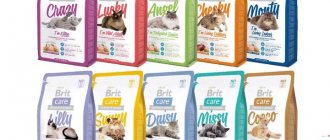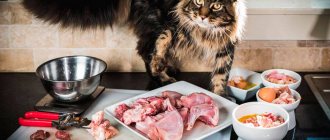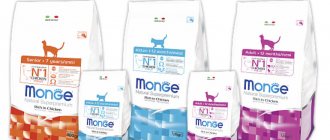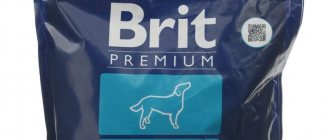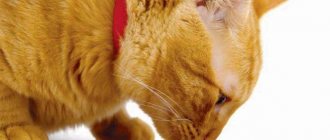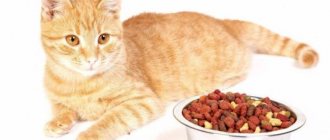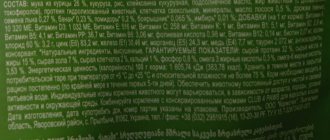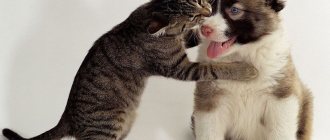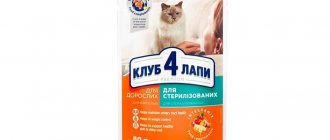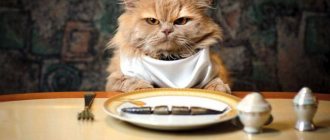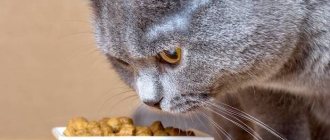Economy class
Economy class food is characterized by a low meat content. It is replaced by various grains, offal and additives. The cat is less likely to eat this food, which means it requires much more of it. When purchasing economy-class food, pay attention to the composition, which should not contain various flavorings and preservatives. The price category is very low, about 20-30 rubles per bag, and a lot of money is spent on promoting the brand.
The most popular representatives of economy class food: Whiskas, Friskies, Kitekat. Veterinarians strongly discourage feeding cats such food on an ongoing basis.
Other features of ready-made cat diets
Dry and wet cat foods come in daily and veterinary grades. The first ones are intended for daily use by healthy cats. The second ones are prescribed by veterinarians for certain diseases. As a rule, the composition of veterinary feeds is characterized by a reduced or increased content of certain substances that help prevent or treat specific diseases. Therefore, veterinary feed cannot be used to feed healthy animals.
We recommend reading: Medicinal food for cats - quality rating
Dry cat food for veterinary use.
In addition to dry, wet and raw food, there are also various treats for cats. These could be pieces of dried meat or offal, something like dry food pellets (only very different in composition), chewing sticks, etc. and so on. All of these treats can be used to pamper your pet or as a reward, but not as a permanent diet.
And yet, quite often the question arises: can a cat eat dry dog food? We answered this in a separate article “Can cats eat dog food: yes, no, and why?”, from which you will learn the difference between food for cats and dogs.
Premium class
Premium is the middle class of cat food. It is better than economy because it assumes a minimal predominance of preservatives and various chemical additives in the feed. The protein of premium feed is mainly represented by poultry meat, carbohydrates - corn. You need to be careful with foods that contain predominantly grain structures, because they are the ones that most often cause allergies in your pet and are much less digestible. Of course, this class of food is much less likely to cause addiction and allergies, but despite this, if you feed your pet premium food on an ongoing basis, do not forget to monitor its health.
The line is most often divided according to taste and age. The most popular brands are Perfect fit, Sheba, Purina one./
What you need to know about the composition of feed
Now let’s talk about the intricacies of food of various classes, which will help you not make a mistake in your choice:
- Always study the composition of the food indicated on the packaging. For quality feeds, the ingredients are indicated as a percentage and in descending order. The absence of this information indicates that this is a product of dubious quality.
- The packaging of high-quality food always indicates what kind of meat was used in its production. If there is no such decoding, this is a lower-than-premium product.
- Pay special attention to identifying the meat component. The mark “dehydrogenated” will indicate that the amount of meat in the feed corresponds to its presence. The absence of such a mark will indicate that the meat in the mixture has a raw appearance, and its quantity is 3 times less than indicated on the label.
- From the feeds, it is better to choose the one whose packaging contains a breakdown of the by-products used in its composition (liver, lungs, heart). The label “animal products” most likely indicates that bones, beaks, hooves and skin were used as by-products.
- Cats are carnivores by nature, which means the lower the grain content in the food, the better.
- The presence of berries and fruit mixtures, probiotics and prebiotics in the composition indicates the high quality of the product.
- The presence of soy or soy concentrate in the feed is undesirable. Along with corn, this product often causes allergies in members of the cat family.
- The mark “poultry” or “animal” fat in the mixture indicates its low quality. A quality product usually lists “fish” or “chicken” fat.
- If your pet has undergone sterilization or castration, if he suffers from obesity or urolithiasis, therapeutic and preventive food will be optimal for him.
- Pregnant and lactating cats will need food with a higher calorie content. Manufacturers of high-quality feed, as a rule, have corresponding lines.
Finally, remember that regardless of the quality of the food purchased, your pet should have free access to water. It will protect your four-legged friend’s body from dehydration!
Super premium cat food
Super-premium food is of high quality, full of useful microelements and a high percentage of meat and fish. You can safely feed your pet with them on an ongoing basis.
Super-premium food can please owners with a wide range - for pets with sensitive digestion, long hair, allergy sufferers, various breeds, food of different textures and many others.
A distinctive feature of food in this category is the detailed composition of the food, indicating all the components.
Super-premium food can only be purchased in specialized stores, pharmacies and clinics.
With this food your pet will be satisfied quickly, but it will provide enough energy for a long time. They are economical in consumption.
The most famous brands of food: “1st Choice” (Fest Choice), “Pro Plan” (Pro Plan), “Cimiao from Farmina” (Kimiao from Farmina).
Tips for feeding your cat
- Your cat should always have access to fresh drinking water. For example, place a large bowl and change the water in it at least once a day;
- Before feeding your cat any food, carefully read the feeding recommendations on the food package;
- It is best to train your cat to eat twice a day - morning and evening. However, if you are constantly at home, you can introduce three meals a day;
- Every cat has individual tastes and not everyone will like the same food. If your cat is allergic to the selected food, try a different brand of food;
- You should not constantly change the brand of food - it is best to choose once and for all. This way, the animal’s stomach won’t have to constantly adapt to new food.
Holistic class
Holistic class is a new generation premium food. It appeared on the feed market relatively recently, but has already managed to win the trust of professionals, breeders and lovers of expensive breeds.
Distinctive features of holistic class feeds:
- High content of natural meat (up to 75%)
- Country of origin: USA, UK, Denmark, Germany.
- Safety. The components included in the composition are confirmed by several organizations - first the FDA (American Food and Drug Association), and then AAFCO (American Association of Food and Drug Administration).
As you can see, the line between super-premium and holistic food is quite blurred. Therefore, we invite you to familiarize yourself with the percentage that holistic class food must meet.
Ratio table for holistic-class dry food
The most famous brands of holistic food are: “Acana”, “Innova”, “Orijen”.
We invite you to familiarize yourself with the ratings of food of various classes:
- Orijen
- Innova Evo
- Eukanuba
- Acana
- 1st Choice
- N&D Natural and Delicious
- Pro Plan
- ProBalance
- Royal Canin
- Hills Science Diet (Prescription Diet)
- Felix
- Sheba
- Friskies/Whiskas
As you can see, holistic and super-premium food top the ratings.
Characteristics
In what packages is it sold?
- ≤ 1 kg : intended for feeding one pet for up to 10-14 days, depending on the diet. Suitable for combining the diet with other species according to the series, purpose or specific characteristics of the animal’s body.
Available in packs, packs with tape for use, boxes.
- 1.1 – 3 kg : intended for complete nutrition of one adult cat for a week or a month with the addition of other food elements to the diet (wet food or pure products). Available in packs and polyethylene packaging.
- 3.1 – 7 kg: packages are available for feeding two or more animals for one month. Suitable for feeding cats for 2-3 months, subject to the rules for storing open food. Available in bags and packs.
- 7.1 – 10 kg : options for economical wholesale purchases, intended for feeding animals or one cat for more than 3 months.
They are produced in bags; when used, you need to pour some of the granules for a week or month into a separate sealed container.
- > 10 kg: available only in bags, suitable for purchasing for several cats for use for 3-6 months. One cat eats 10 kg of dry granules in 8-10 months.
To feed, you need to pour out part of the food for a week or a month, and seal the rest tightly in the bag.
For what ages
When choosing industrially produced food, pay attention to the age of the animal and the types of food that are calculated by category. You cannot feed kittens with food for adult animals, but the opposite situation is acceptable, with the grams recalculated upward.
- Kittens: special series are produced for animals aged 0-4 months. The food composition replaces mother's milk, bait is introduced from the second week of the animal's life (if there is no possibility of natural feeding, then from the first day).
The chemical composition of the food is similar to milk, which contains a large amount of fat and protein.
- Young: for growing organisms, feeds are produced with a high content of protein and glucose, which are necessary for building muscles and normal development of the body. Between 3 and 9 months, young cats eat twice as much as adults.
The average weight of the animal during this period is 1-3 kg.
- Adults: cats eat 150-200 grams of food per day, the figure is calculated for an individual 1.5-8 years old with a body weight of 2-6 kg (depending on gender and breed). The food contains more protein and less carbohydrates.
- Elderly: for cats aged 8-15 years, a separate series of food is produced, which includes less carbohydrates, more protein and healthy vitamins, as well as substances for correcting urination.
Food for different breeds
- Long-haired: for cats of these breeds, special food is produced with a complex of vitamins and elements for removing hair from the body (an adult long-haired cat accumulates hair in the stomach in seven days, which clogs it by a third).
This type is assigned to short-haired breeds when problems arise with removing hair from the body.
- Short-haired: food is produced that is not oversaturated with vitamins for hair growth and substances for removing it from the body.
Cat food series
- Everyday food : a series containing a standard set of nutrients and vitamins. Produced on the basis of natural ingredients (poultry, fish, meat), mixed versions are also available.
It differs from each other not in calorie content, but in ingredients: rabbit, beef, chicken, salmon.
- Medicinal food: varieties are produced to solve a specific problem (urolithiasis, tooth and hair loss, obesity, for diseases of the stomach, gastrointestinal tract, constipation, after surgery, after childbirth).
- Light food: an option for obese cats who are used to eating in large quantities.
This is a low-calorie product: if a normal adult cat needs 150-200 g of food per day, then a lightweight version with low energy value weighs 200-350 g.
- Food for pregnant cats: products rich in vitamins, proteins and fats that support the body of the cat and future kittens. You cannot give a pregnant cat additional vitamins and bait if she eats specialized food.
- Food for nursing cats: food with a high content of proteins and fats, multivitamins is available. The diet supports newborn kittens through milk. Supports lactation.
- Sterilized: the amount of phosphorus and magnesium in the feed is limited, which cause urolithiasis in castrated animals.
Purpose
- For digestion: the composition includes enzymes that help digest food. Prescribed to pets who refuse to eat normally for their weight category.
- To keep the skin and coat in good shape: the composition includes a set of minerals and vitamins necessary to maintain the animal’s body in normal condition.
Prescribed for pets with allergies, hair loss problems, and skin diseases.
- Caring for teeth: this is a series with special food fibers that have undergone additional processing. The composition and consistency does not harm the enamel and does not contribute to the formation of tartar. Includes a complex of vitamins against tooth loss.
- For joint health: classified as medicinal, prescribed by a veterinarian. It is not recommended to feed your cat this food without prior consultation.
- Food for maintaining kidney health: a medicinal variety that is prescribed when a cat is diagnosed with kidney failure.
- For the immune system : a type of medicinal food that is prescribed during and after illness associated with viruses. There are two types of feeding: course and continuous use.
- To maintain physical fitness : super-premium series or holistic class. Consists entirely or 60% of natural balanced ingredients. Prescribed for purebred and elderly animals.
An excellent food option for cats that live indoors.
- Food for picky cats: a super-premium series, which consists of 50% natural ingredients. Produced for picky and purebred cats who need a fortified diet.
- Hypoallergenic: a series with a balanced system of minerals and the addition of glucose, suitable for cats with problems and allergic reactions to food additives.
- Food for obese cats: a special series for overweight cats (6-10 kg, when the ribs cannot be felt, the cat cannot clean the back area near the tail on its own). The composition has reduced the amount of fat.
Main Ingredients
Poultry: Duck, chicken, entrails are used. Economy class series use processed products, higher premium series use 50-80% natural poultry meat.
Meat: used rabbit, beef, lamb. Elite foods contain natural meat. In the middle classes there is only a processed product.
Fish: salmon, seafood, gobies. In the economy class series it is fish oil, in the premium series it is fish.
Classes
Advertising slogans do not belong to the classification; more often they are only statements of a marketing nature. The real class will be written on the back of the package, in the information about the type of food next to the composition.
Economy
The main ingredients used are by-products (ground cartilage, entrails, skin), some cereals, and soybeans. The products are low-calorie. Animal fats predominate over vegetable fats.
May cause allergic reactions due to fragrances and dyes. Feed consumption is higher than other classes due to low energy value.
Premium
This premium food is designated by the quality control acronym AAFCO (American Association). Protein is always listed first, which should be at least 25%. The class is also distinguished by the inclusion of basic vitamins: C and E.
Pay attention to the calculation of portions for an adult cat on the back of the pack: the lower the number, the better the pet assimilates the product.
Important: flour, by-products, preservatives, and cereals should not be contained in premium food; additional ingredients up to 50% are allowed. If they are included, then this is a fake.
Super premium
Balanced food for cats. The composition includes natural vegetables, chicken, turkey and lamb fillets, eggs and nutritious cereals (rice).
It is small and medium-sized granules of a light brown hue. The composition of the food corresponds to the stage of life of the animal; food is produced for kittens, pregnant, lactating, neutered and elderly cats.
Holistic
These are elite foods that are specially developed for artificially bred cat breeds. They are hypoallergenic and suitable for problematic digestion and picky pets.
The difference from the super-premium class is its 100% ecological composition, the addition of useful plants and substances.
Holistic is used in breeding nurseries and is fed to exhibition winners. The components of the food are selected as close as possible to the natural diet of a wild cat, and therefore are best absorbed.
The class indicator is a natural composition, the share of meat is more than 50%.
General recommendations for choosing food:
- When purchasing food, pay attention to the percentage of meat/by-products. In economy food it is significantly lower than in super-premium and holistic class. In a good food, the percentage of meat should be in the range of 30-45%, so if the packaging says that the content is 100%, then most likely this is just an advertising ploy and you should carefully read the composition.
- The food should not contain various harmful additives (dyes, additives with the prefix E), as well as salt, yeast, and animal mixtures. They can cause allergies and provoke various diseases. In addition, the signature “tasteful” can most often indicate the presence of harmful flavorings in the food. Also, in no case should the food contain the H127 dye, which can activate the growth of cancer cells.
- When choosing food, be sure to take into account the breed, age, health and physical activity of your pet. It is best to consult a veterinarian first to avoid problems caused by incorrect selection. Often certain breeds are prone to certain diseases. Of course, food alone cannot cure them, but it will help maintain health and not aggravate the condition.
We remind you that recommended feeding rates for cats depend on their age and weight:
Wet
These include:
- meat;
- fish;
- bouillon.
Depending on the class, the protein component in it can be from 50% to 90%. The product is packaged in packs and undergoes heat treatment, as a result of which useful substances remain in the jelly.
Such food has an important positive aspect - a variety of tastes, thanks to which even the most capricious cat can eat what he likes.
They have a short shelf life: usually it is better not to leave them open for more than 12 hours. In addition, soft pieces are not able to remove tartar, so we are not talking about its prevention in this case either. As for the cost, good wet food is expensive: not every owner can afford to include it in the pet’s daily diet.
